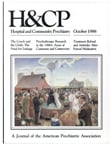Overlapping Symptoms of Geriatric Depression and Alzheimer-Type Dementia
Abstract
The occurrence of geriatric depression and dementia of the Alzheimer type, two of the most common diseases of late life, is certain to increase as the proportion and absolute number of Americans over the age of 65 grow larger. Overlapping symptomatology can sometimes make it difficult to determine whether a patient suffers from geriatric depression with cognitive abnormalities, Alzheimer-type dementia with depressive symptoms, or coexisting depression and dementia. In this review of the course, symptomatology, and pathophysiology of Alzheimer-type dementia and geriatric depression, the authors describe the symptoms often shared by these diseases as well as the characteristics usually associated with one or the other. Factors that complicate diagnosis, such as the presence of other medical illnesses and pharmacokinetic and pharmacodynamic changes associated with aging, are also discussed.
Access content
To read the fulltext, please use one of the options below to sign in or purchase access.- Personal login
- Institutional Login
- Sign in via OpenAthens
- Register for access
-
Please login/register if you wish to pair your device and check access availability.
Not a subscriber?
PsychiatryOnline subscription options offer access to the DSM-5 library, books, journals, CME, and patient resources. This all-in-one virtual library provides psychiatrists and mental health professionals with key resources for diagnosis, treatment, research, and professional development.
Need more help? PsychiatryOnline Customer Service may be reached by emailing [email protected] or by calling 800-368-5777 (in the U.S.) or 703-907-7322 (outside the U.S.).



